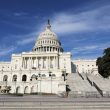Historic infrastructure investment presents opportunity to improve roadway safety
Two years ago, the pandemic changed everything—remote work became normalized; the popularity of delivery services went through the roof; roadway deaths spiked with fewer commuters and wide-open highways.
They haven’t come down.
“The reality in America right now is that no matter the size of your community or whether it is urban, suburban or rural, this persistent issue hits hard at home and in your districts,” said Elaine Clegg, city council president in Boise, Idaho, testifying on behalf of the National League of Cities (NLC) during a recent hearing on highway safety in front of the House Committee on Transportation and Infrastructure. “So many communities are concerned—from Idaho’s communities to Doraville, Ga., to Ferndale, Mich., to Greenville, N.C., to Culver City, Calif.—and taking action to set up plans and projects despite tough recovery budget cycles and difficult decisions.”
Last year, the National Highway Traffic Safety Administration estimates that about 42,915 people were killed on American roadways, according to Delegate Eleanor Holmes Norton (D-D.C.), chair of the Subcommittee on Highways and Transit. Traffic fatalities increased by 19 percent during the pandemic, accelerating a trend that began before stay-at-home orders were commonplace. In the last decade, pedestrian and bicycle deaths are up 62 percent—disproportionately impacting African Americans and elders.
“Older Americans are especially vulnerable and make up an outsized proportion of the yearly deaths, with fatalities increasing at a rate of 13 to 17 percent of all deaths for pedestrians,” Clegg said. “Fatalities among older Americans have increased 17 to nearly 20 percent of all deaths. Idaho had the most traffic deaths in 16 years in 2021, and one of the highest rates of increase in the nation at 36 percent—that is three times the average rate of increase in other states.”
Nationwide, Americans are twice as likely to be killed on the road compared to Canada, and four times more likely than in leading Western European countries, according to Rep. Peter DeFazio (D-OR), chair of the House Committee on Transportation and Infrastructure, during opening remarks for the hearing. It doesn’t have to be like that.
“These countries have long acknowledged the risk of dangerous road design, embraced robust vision zero and complete streets policies, and provided many safe and convenient alternatives to driving,” DeFazio said.
With a historic amount of federal dollars dedicated to infrastructure updates via recent legislation, there’s an opportunity to change precedence and reduce highway deaths.
But it’ll take collective action roadway safety at all levels of government to make a lasting impact.
“Collectively, federal, state and local governments must be willing to adjust our rules of the road for design and speed in order to save lives,” Clegg said. “Cities and towns have found that federal measures and designs rely too heavily on car throughput measures set during the era of freeway building to keep single-purpose, high-speed, limited access roadways safe and moving.”
Cities aren’t just highways. They’re main streets and side streets with many access points.
There are proven ways to make America’s roadways safer. A pilot project in rural Maryland conducted by the Governors Highway Safety Association, the Insurance Institute for Highway Safety and the National Road Safety Foundation, for example, reduced average speeds by nearly 10 percent. The project, on a 2.4 mile stretch of a two-lane road in Bishopville, Md.—a popular beachgoer destination during the summer months that’s known for speeding. The lanes were narrowed by doubling the painted edge’s width and widening the center lines to 10 inches. Speed feedback signs showing drivers how fast they were going were installed in two places. Simultaneously, highway officials let the public know about the lane narrowing and that the area was a focus for traffic enforcement. Along with a decline in average speeds, drivers were nearly 80 percent less likely to exceed the speed limit at all.
“As we begin a great time of rebuilding America’s infrastructure, we need to work together to quickly adopt better measures and designs that can take into account more factors like speed, distance, impact on non-drivers, and time of travel,” Clegg said. “We believe that if we reset our goals and allow safety to be the primary measure, transportation engineers can modernize the foundational cost-benefit transportation measures and truly assess the costs America is now paying in lives.”
Notably, Norton said elements included in the Bipartisan Infrastructure Law will “shift the focus to safe mobility for all,” she said. “It is much stronger on roadway safety than any previous surface transportation law has been. It provides states and local governments key policy direction and historic funding to invest in roadway safety. States and their local partners now have the responsibility to think creatively, invest wisely, and begin to make real change.”




















